Petrels are a medium-sized bird, characterised by united nostrils with medium septum, and a long outer functional primary. The petrel is dominant in the Southern Oceans, but not in the Northern Hemisphere.
The word petrel comes from the Latin name for the Christian Saint Peter, and refers to the habits of certain species to hover just above the ocean waves, with their feet barely touching the water, thus giving an appearance of walking on water, as Peter is said to have done.
In Kaikoura we have fourteen Petrel varieties.
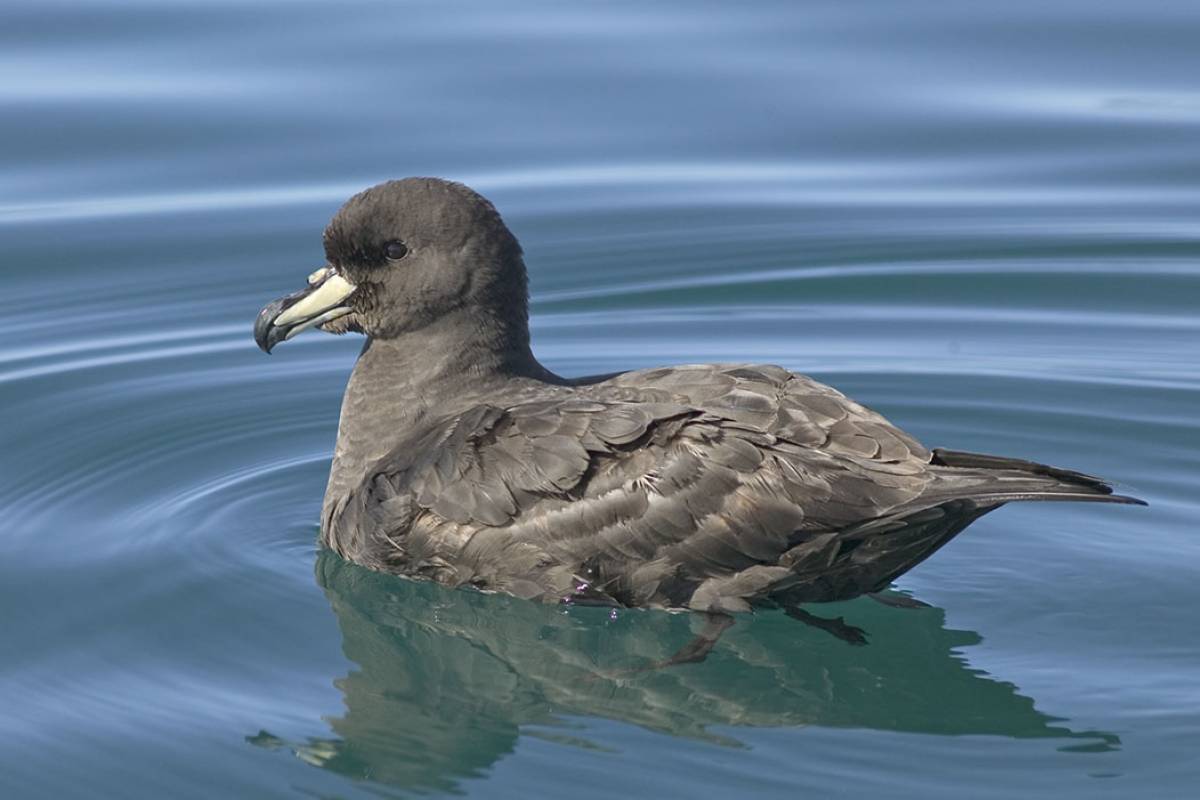
Black Petrel
Black petrels are not as commonly seen in Kaikoura.
The black petrel (Procellaria parkinsoni) is very similar to the white-chinned petrel and Westland petrel, but is smaller in size. Normally more frequently seen around northern New Zealand, especially the outer Hauraki Gulf. The black petrel breeds in burrows on Great Barrier Island and Little Barrier Island in the Hauraki Gulf
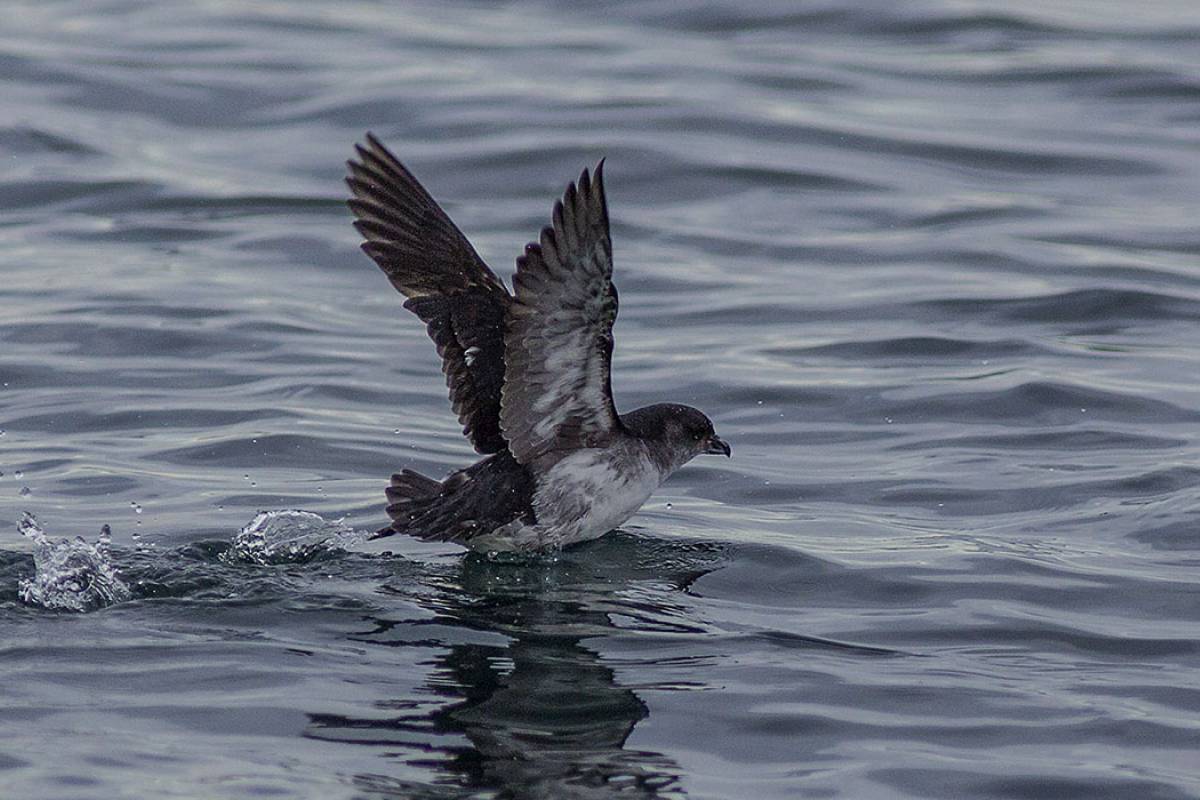
Diving Petrel
A very small black and white bird which flies close to the water with rapid wing beats, a buzzing flight giving the appearance of an over-sized bumble bee.
The diving petrel (Pelecanoides urinatrix) is one of the smallest seabirds found in New Zealand, waters weighing only 130 grams! You'll see them several miles off the Kaikoura Coast during the winter months. They're generally on their own, but occasionally you can find small flocks. They breed on offshore islands throughout New Zealand. The closest breeding colony to Kaikoura is in the Marlborough Sounds. As their name suggests, diving petrels are excellent divers and use their wings to fly underwater. They dive into the water whenever threatened and have the ability to fly straight through waves!
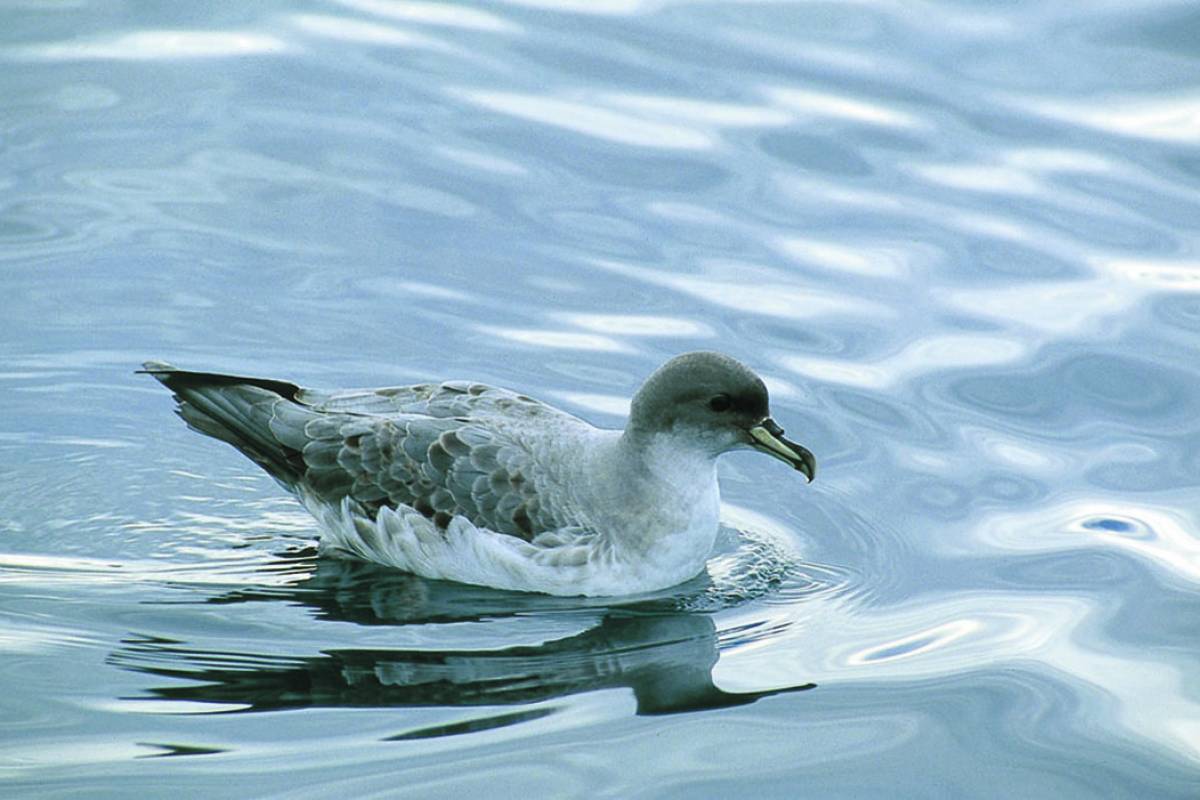
Grey Petrel
The grey petrel is a inquisitive bird and will put is head underwater and energetically swim around fishing boats looking for food scraps.
The grey petrel (Procellaria cinerea) is a plump, grey-coloured petrel, similar in size to a Westland. The occasional grey petrel is seen off Kaikoura in the winter, usually more than 5 miles out. They often congregate around fishing boats. The grey petrel dives to depths of up to 22 metres by using its wings underwater. Since they can dive so deep and are attracted to food scraps around fishing boats, there is some concern about the number of grey petrels caught on baited fish hooks, especially in the southern blue-fin tuna fishery. The grey petrel breeds on sub-Antarctic Islands in the Pacific, Atlantic and Indian Oceans, and nests in burrows.

Westland Petrel
The Westland petrel is the largest burrowing petrel still breeding on the New Zealand mainland
The Westland petrel's (Procellaria westlandica) larger size and aggressive temperament affords it some protection from the introduced predators that have destroyed other mainland petrel colonies. The egg is incubated continuously, and the chick, once hatched, is constantly guarded for up to six weeks by one or both parents, providing protection from predators during these vulnerable periods. Westland petrels are solitary at sea when feeding on natural foods, but may feed in mixed flocks when attending fishing vessels to feed on fishery waste. They feed by surface-seizing and diving. Westland Petrels return to their sole breeding ground in the coastal ranges near Punakaiki, on the West Coast of New Zealand, from May or June and remain there until around mid-January. Westland petrels can breed from 5 years-old, but 10 years is typical.

White-chinned Petrel
Called Shoemaker by the early sealers who visited the Subantarctic Islands because of the sound the bird makes in its burrow, a succession of clacks and rattles.
White-chinned petrels (Procellaria aequinoctialis) can be seen off the Kaikoura Coast mainly during late spring and summer, generally as single birds. White-chinned petrels are not as common as Westland petrels off the Kaikoura Coast, although groups of up to 15 inquisitive birds can be seen around fishing boats. They're generally found further offshore than the Westland petrel, but are occasionally seen about a mile off the coast. A white-chinned petrel can dive to depths of 10 metres or more using its wings to fly underwater. The white-chinned petrel is larger than the Westland petrel and is distinguished by the lack of a black tip on its beak. While most birds have a white chin, it's usually very difficult to see.

Cape Petrel
One of the most distinctively coloured petrel species with a mottled black and white colouration, also known widely as “Pintado petrel."
Cape petrels (Daption capense) are seen off Kaikoura throughout the year with flocks of hundreds of birds seen from late autumn to early spring, having moved north from the waters around Antarctica and New Zealand’s Subantarctic Islands. They are the noisiest petrel species at sea (most petrels are silent at sea) and flocks can be heard making a distinctive chuckling sound. They are attracted by feeding whales and fur seals and keep an eye open for any food scraps. Cape petrels are also known as cape pigeons, because of the way they bob their head back and forth like feral pigeons in parks and because of their presence around the windswept Cape Horn. But the name is misleading. Two subspecies are recognised, the Cape petrel (Daption capense), which breeds on mainland Antarctic and Antarctic Peninsula and Antarctic and subantarctic islands outside of New Zealand and the Snares Cape petrel (Daption australe) which breeds on the Snares, Bounty, Antipodes, Auckland and Chatham Islands in the New Zealand region.

Northern Giant Petrel
Adult birds have a brownish tip to their beaks, which is the distinguishing feature from the southern giant.
The northern giant petrel (Macronectes halli) is sighted off Kaikoura throughout the year. It's generally seen alone soaring on ocean swells, unless it's feasting on a carcass or scavenging on food remains brought to the surface by sperm whales or fur seals, or offal from fishing boats. Groups of up to nine birds or more can also be seen scavenging around fishing boats. Northern giants are rarer worldwide, but more common in the coastal waters around New Zealand. The northern giant is also called "Nelly Bird", as its aggressive antics amuses fisherman. It's circumpolar, but unlike the southern giant, it breeds on many of New Zealand's subantarctic islands and is a predator of smaller seabirds.
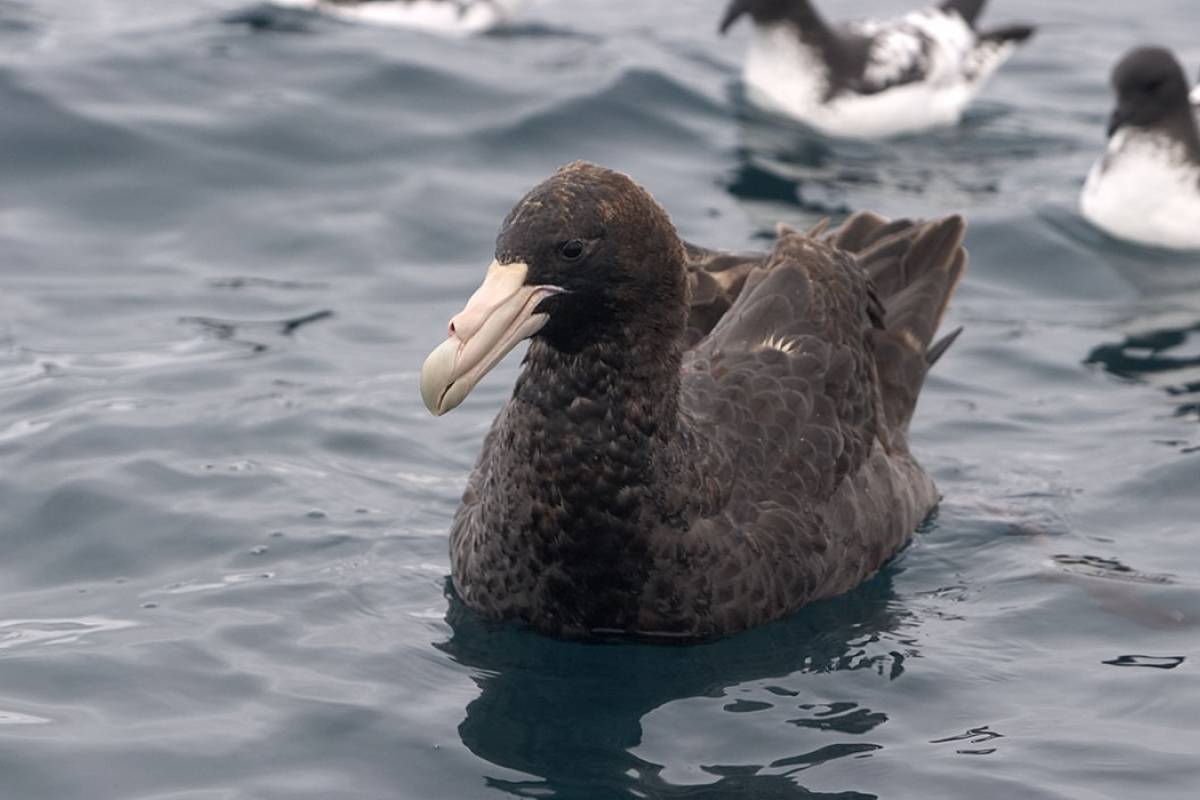
Southern Giant Petrel
Has a large and distinctive hooked beak, hence called the 'Sea Vulture'. It has a fierce looking appearance. and is the largest of the petrel species.
Slightly smaller than the lesser albatross (mollymawks), southern giant petrels (Macronectes giganteus), like their northern counterparts, will attack and eat smaller species of seabirds. They are also generally scavengers and are frequently seen around anything dead floating on the surface or around feeding fur seals and sperm whales. They also naturally feed on squid. The southern giant has two colour phases, a dark phase, which is easily confused with the northern giant petrel (although the northern giant petrel has a brown tip to its bill) and the distinctive white morph giant petrel. White morph giant petrels are seen off Kaikoura each winter and around 10% of southern giants are white-morph birds (which blend into the snow-covered areas where the birds breed). Southern giants breed on ice free islands around the Antarctic Continent.

White Morph (Southern Giant) Petrel
The White Morph is a Southern giant petrel. About 10% of southern giant petrels are a distinctive white morph (with sparse black feathers and brown eyes)
The Southern Giant Petrel are the largest petrel species, reaching the size of a small albatross. They are aggressive and opportunistic, scavenging penguin, albatross, seal and whale carrion, and ship offal, and preying on penguin and albatross chicks and other seabirds up to the size of an adult albatross. They also take fish and squid from the sea surface.

Grey-faced Petrel
The grey-faced petrel is a large dark gadfly petrel with long narrow wings and a long pointed tail. The entire body is uniformly dark black-brown but with occasional paler brown worn feathers.
The grey-faced petrel (Pterodroma macroptera) is an all dark oceanic seabird with a short, but powerful deeply-hooked beak. At sea, it is fast and graceful with a high soaring powerful flight on long narrow wings. Grey-faced petrels breed around northern New Zealand on islands as well as on a few mainland headlands. The birds begin breeding in the middle of winter, but many chicks don’t fledge until the height of summer. The grey-faced petrel is sometimes referred to as the northern muttonbird, and some Māori still exercise their rights to harvest the petrel chicks between mid-November and mid-December each year. Grey-faced petrels are making a comeback as many breeding islands have been cleared of pests.
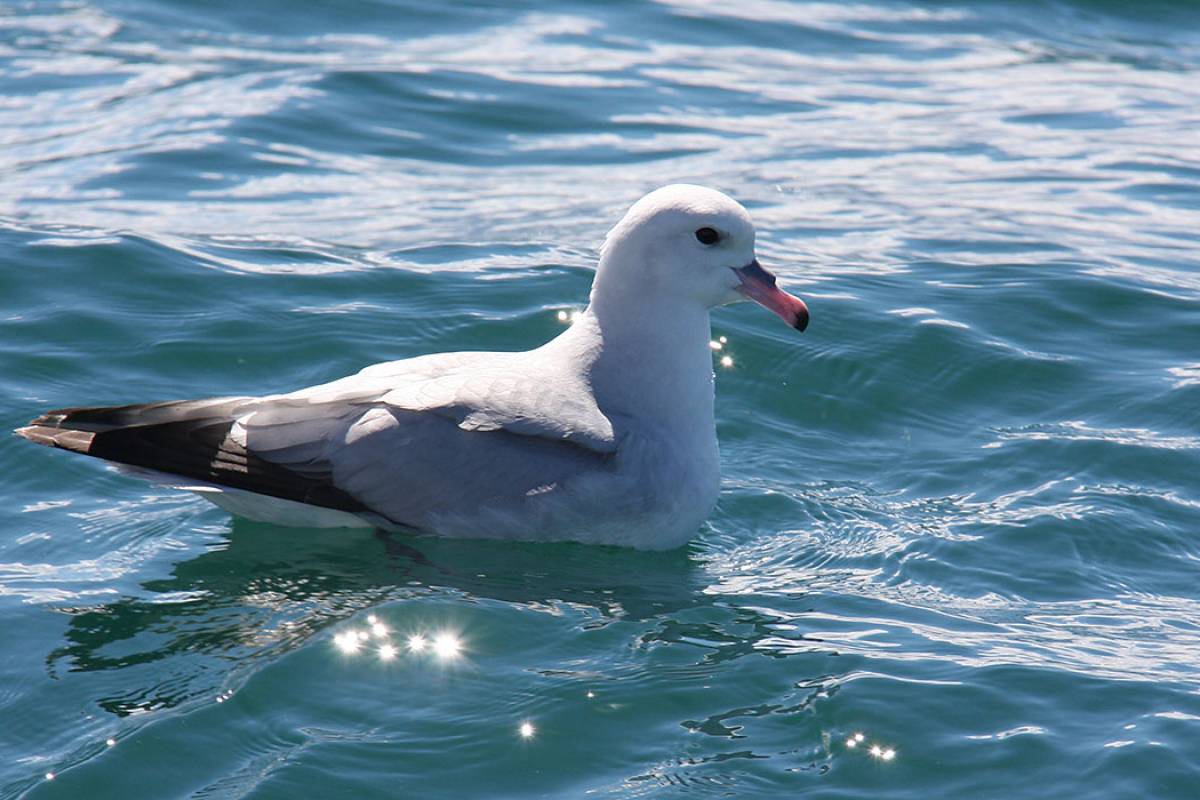
Antarctic Fulmar
Often seen alone out at sea. Individual Antarctic fulmars are seen off the Kaikoura Coast from May to September
The Antarctic fulmar (Fulmarus glacialoides) is a medium-sized fulmarine petrel, grey and white, with almost a tinge of blue in its colours. It resembles a large seagull, but is easily distinguished from the seagull by its stiff wings and rapid wing beats, followed by periods of gliding – a characteristic flight pattern of petrels. The Antarctic fulmar breeds on rocky islets around Antarctica. Colonies of more than a million birds are crowded onto small rocky islets. Birds feed on the rich krill food source around Antarctic waters in the summer and birds move north over the winter. Antarctic fulmar are attracted to fishing boats for food-scraps, although they are not as an aggressive feeder as the closely-related cape petrel (pigeon).

Grey-backed Storm Petrel
A sparrow sized bird, weighing only 35 grams, yet quite at home flying in full force gales in New Zealand's subantarctic waters.
The grey-backed storm petrel (Garrodia nereis) is the most likely species of storm petrel to be seen off the Kaikoura Coast, although it's still only a rare visitor. While we get occasional sightings of Wilson's and white-faced storm petrels, the grey-backed is more commonly sighted. When it does visit, it's most likely to be in the winter months, but it could be seen at any time of year. In South Island waters it's generally seen well offshore. It has a distinctive fluttering style of flight close to the waves. It breeds on islands throughout the subantarctic, where it nests in burrows.
Recent Bird Sightings
With around 150 species of birds recorded here so far, Kaikoura is one of New Zealand's top birding destinations. The wonderful array of seabirds just offshore are the jewel in the crown with five varieties of Great Albatross, nine varieties of the smaller Lesser Albatross, seven varieties of Shearwaters, fourteen Petrel varieties, and several other seabird varies such as Shags, Prions, Penguins, Gulls and Terns.